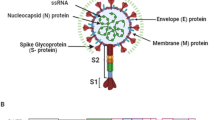Abstract
Screening for new antiviral drugs is concentrated on a search for inhibitors of the human immunodeficiency virus, herpesviruses, influenza virus, hepatitis B virus and rhinovirus. The first step in the process is usually the screening of virus-infected cell cultures followed by secondary screening in infected animals. The relevance of the different screening methods for predicting clinical efficacy is at present uncertain due to the low number of compounds evaluated in double-blind placebo-controlled clinical trials. As a consequence of the con-siderable activity in ongoing research on antiviral drugs the predictive value of the screening systems is expected to improve.
Similar content being viewed by others
References
Öberg B: Inhibition of virus-specific enzymes. In: Stuart-Harris CH, Oxford J (ed): Problems of antiviral therapy. Academic Press 1983, p. 35–69.
Galasso GJ, Merrigan TC, Buchanan RA: Antiviral agents and viral diseases of man. Raven Press, New York, 1984.
Oxford J, Öberg B: Conquest of viral diseases: a topical review of drugs and vaccines. Elsevier, Amsterdam, 1985.
Hu JM, Hsiung GD: Evaluation of new antiviral agents. I: In vitro perspectives. Antiviral Research 1989, 11: 217–232.
Hsiung GD, Chan VF: Evaluation of new antiviral agents. II: The use of animal models. Antiviral Research 1989, 12: 239–258.
Field HJ, Brown GA: Animal models for antiviral chemotherapy. Antiviral Research 1989, 12: 165–180.
Tyrell DAJ, Al-Nakib W: Prophylaxis and treatment of rhinovirus infections. In: DeClercq E (ed): Clinical use of antiviral drugs. Martinus Nijhoff, 1988, 241–276.
Hayden FG, Cote KM, Douglas RG: Plaque inhibition assay for drug susceptibility testing of influenza viruses. Antimicrobial Agents and Chemotherapy 1981, 17: 865–870.
Aoki FY, Stiver HG, Sitar DS, Boudreault A, Ogilvie RI: Prophylactic amantadine dose and plasma concentration-effect relationships in healthy adults. Clinical Pharmacology and Therapeutics 1985, 37: 128–136.
Gilbert BE, Wilson SZ, Knight V, Couch RB, Quarles TM, Dure L, Hayes N, Willes G: Ribavirin small-particle aerosol treatment of infections caused by influenza virus strains A/Victoria/7/83 (HINI) and B/Texas/1/84. Antimicrobial Agents and Chemotherapy 1985, 27: 309–313.
Öberg B, Johansson NGJ: The relative merits and drawbacks of new nucleoside analogues with clinical potential. Journal of Antimicrobial Chemotherapy 1984, 14, Supplement A: 5–26.
Larsson A, Stenberg K, Ericson AC, Haglund U, Yisak WA, Johansson NGJ, Öberg B, Datema R: Mode of action, toxicity, pharmacokinetics and efficacy of some new antiherpesvirus guanosine analogs related to buciclovir. Antimicrobial Agents and Chemotherapy 1986, 30: 598–605.
O'Brien JJ, Campdis-Richards DM: Acyclovir. An updated review of its antiviral activity, pharmacokinetic properties and therapeutic efficacy. Drugs 1989, 37: 229–390.
Öberg B: Antiviral effects of phosphonoformate (PFA, foscarnet sodium). Pharmacology and Therapeutics 1989, 40: 213–285.
Kristoffersson A, Ericson AC, Sohl-Åkerlund A, Datema R: Limited efficacy of inhibitors of herpes simplex virus DNA synthesis in murine models of recrudescent disease. Journal of General Virology 1988, 69: 1154–1166.
Harmenberg J, Stenberg K: Antiviral activities of guanosine analogs in guinea pig embryonic fibroblasts. Antimicrobial Agents and Chemotherapy 1988, 32: 1533–1536.
Soike KF, Felsenfeld AD, Gerone PJ: Acyclovir treatment of experimental simian varicella infection in monkeys. Antimicrobial Agents and Chemotherapy 1981, 20: 291–297.
Lake-Bakaar DM, Abele G, Lindborg B, Soike KF, Datema R: Pharmacokinetics and antiviral activity in simian varicella virus-infected monkeys of (R,S)-9-[4-hydroxy-2(hydroxymethyl)butyl] guanine, an antivaricella zoster virus drug. Antimicrobial Agents and Chemotherapy 1988, 1807–1812.
Skolnik PR, Hirsch MS: Therapy and prevention of cytomegalovirus infections. In: DeClercq E (ed): Clinical use of antiviral drugs. Martinus Nijhoff, 1988, p. 159–194.
Öberg B: Antiviral therapy. Journal of Acquired Immunodeficiency Syndromes 1988, 1: 257–266.
Gardner MB, Luciw PA: Animal models of AIDS. FASEB Journal 1989, 3: 2593–2606.
Spertzel RO and the Public Health Service Animal Models Committee: Animal models of human immunodeficiency virus infection. Antiviral Research 1989, 12: 22–230.
McClure HM, Anderson DC, Fultz PN, Ansari AA, Lockwood E, Brodie A: Spectrum of disease in macaque monkeys chronically infected with SIV/SMM. Veterinary Immunology and Immunopathology 1989, 23: 13–24.
Putkonen P, Warstedt K, Thorstensson R, Benthin R, Albert J, Lundgren B, Öberg B, Norrby E, Biberfeld G: Experimental infection of cynomolgus monkeys (Macaca fascicularis) with simian immunodeficiency virus. Journal of Acquired Immunodeficiency Syndromes 1989, 2: 359–365.
Namikawa R, Kaneshima H, Lieberman M, Weissman IL, McCune JM: Infection in the SCID-hu mouse by HIV-1. Science 1988, 242: 1684–1686.
Bazin H, Chattopadhaya J, Datema R, Ericson AC, Gilljam G, Johansson NGJ, Hansen J, Koshida R, Moelling K, Öberg B, Remaud G, Stening G, Vrang L, Wahren B, Wu JC: An analysis of the inhibition of replication of HIV and MuLV by some 3′-blocked pyrimidine analogs. Biochemical Pharmacology 1989, 38: 109–119.
Fischl MA, Richman DD, Grieco MH, Gottlieb MS, Volberding PA, Laskin OL, Leedom JM, Groopman JE, Mildvan D, Schooley RT, Jackson GG, Durack DT, King D: The efficacy of azidothymidine in the treatment of patients with AIDS and AIDS-related complex. New England Journal of Medicine 1987, 317: 185–191.
Lambert JS, Scidlin M, Reichman RC, Plank CS, Laverty M, Morse GD, Knupp C, McLaren C, Pettinelli C, Valentine FT, Dolin R: 2′3′-dideoxyinosine (ddI) in patients with the acquired immunodeficiency syndrome or AIDS-related complex. New England Journal of Medicine 1990, 322: 1333–1340.
Löfgren B, Nordenfelt E, Öberg B: Inhibition of RNA-versus DNA-dependent duck hepatitis B virus DNA polymerase activity by nucleoside and pyrophosphate analogs. Antiviral Research 1989, 12: 301–310.
Sherker AH, Hirota K, Omata M, Okuda K: Foscarnet decreases serum and liver duck hepatitis B virus DNA in chronically infected ducks. Gastroenterology 1986, 91: 818–824.
Nordenfelt E, Löfgren B, Chattopadhaya J, Öberg B: Inhibition of hepatitis B virus DNA polymerase by 3′-azido-3′-deoxythymidine triphosphate but not by its three analogues. Journal of Medical Virology 1987, 22: 231–236.
Author information
Authors and Affiliations
Rights and permissions
About this article
Cite this article
Öberg, B., Vrang, L. Screening for new agents. Eur. J. Clin. Microbiol. Infect. Dis. 9, 466–471 (1990). https://doi.org/10.1007/BF01964285
Issue Date:
DOI: https://doi.org/10.1007/BF01964285




